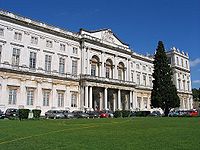
Cancioneiro da Ajuda
Encyclopedia


Galician-Portuguese
Galician-Portuguese or Old Portuguese was a West Iberian Romance language spoken in the Middle Ages, in the northwest area of the Iberian Peninsula. It was first spoken in the area bounded in the north and west by the Atlantic Ocean and the Douro River in the south but it was later extended south...
language and probably dating from the last quarter of the 13th century. It is the oldest of the Galician-Portuguese cancioneiros with secular music.
The Cancioneiro is kept in the library of the Ajuda National Palace
Ajuda National Palace
The Ajuda National Palace is a neoclassical monument in the civil parish of Ajuda in the city of Lisbon, centralPortugal. Built on the site of a temporary wooden building constructed to house the Royal family after the 1755 earthquake and tsunami, it was originally begun by architect Manuel...
, a former royal residence located in Lisbon. It consists of a parchment
Parchment
Parchment is a thin material made from calfskin, sheepskin or goatskin, often split. Its most common use was as a material for writing on, for documents, notes, or the pages of a book, codex or manuscript. It is distinct from leather in that parchment is limed but not tanned; therefore, it is very...
codex
Codex
A codex is a book in the format used for modern books, with multiple quires or gatherings typically bound together and given a cover.Developed by the Romans from wooden writing tablets, its gradual replacement...
written in Gothic script
Gothic script
Gothic script may refer to:* Blackletter* Gothic alphabet* Schwabacher...
by three hands and containing illuminated miniatures
Miniature (illuminated manuscript)
The word miniature, derived from the Latin minium, red lead, is a picture in an ancient or medieval illuminated manuscript; the simple decoration of the early codices having been miniated or delineated with that pigment...
. Both the text and the miniatures remained unfinished and not a note of music was written in the space left for it. The whole codex contains 310 poems, nearly all of them cantigas de amor (male-voiced love songs, though a few are satiric and there are a few male/female dialogs).
The first (crude) edition dates from 1823, but a monumental critical edition, still a standard work, was published by the German-born Romance philologist Carolina Michaëlis de Vasconcellos
Carolina Michaëlis de Vasconcellos
Carolina Michaëlis de Vasconcelos, born Karoline Michaelis was a German-Portuguese romanist.She was born in Berlin as the last of five children of Gustav Michaelis, a mathematics teacher...
in 1904. An important paleographic transcription was published by American scholar Henry H. Carter in 1941.
See also
- Portuguese literaturePortuguese literatureThis is a survey of Portuguese literature.The Portuguese language was developed gradually from the Vulgar language spoken in the countries which formed part of the Roman Empire and, both in morphology and syntax, it represents an organic transformation of Latin without the direct intervention of...
- Cancioneiro da Biblioteca NacionalCancioneiro da Biblioteca NacionalThe Cancioneiro da Biblioteca Nacional , commonly called Colocci-Brancuti, is a compilation of Galician-Portuguese lyrics by both troubadours and jograes...
- Cancioneiro da VaticanaCancioneiro da VaticanaThe Cancioneiro da Vaticana is a compilation of troubadour lyrics in Galician-Portuguese. It was discovered c. 1840 in the holdings of the Vatican Library and was first transcribed by Ernesto Monaci in 1875....
- Cantiga de amigoCantiga de amigoThe Cantiga de amigo or Cantiga d'amigo , literally a "song about a boyfriend", is a genre of medieval erotic lyric poetry, apparently rooted in a song tradition native to the northwest quadrant of the Iberian Peninsula. What mainly distinguishes the cantiga de amigo is its focus on a world of...
- TroubadourTroubadourA troubadour was a composer and performer of Old Occitan lyric poetry during the High Middle Ages . Since the word "troubadour" is etymologically masculine, a female troubadour is usually called a trobairitz....

